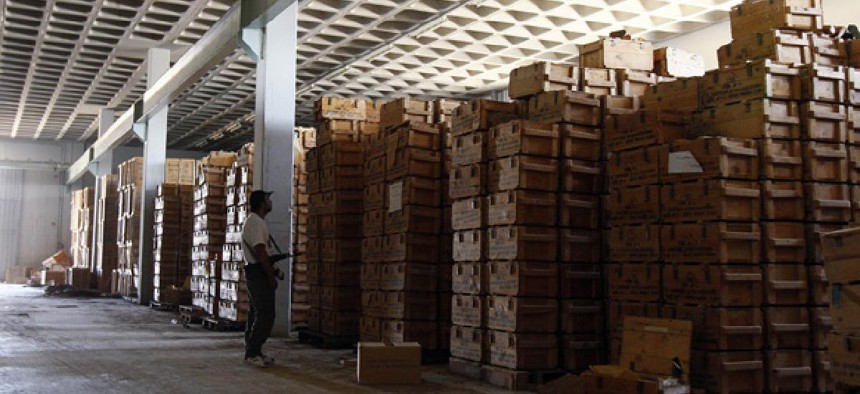
Francois Mori/AP
Long haul for U.S. to secure weapons stockpiles in Libya
Some missing antiaircraft missiles may have left the country.
In a sobering update on the effort to secure loose weapons in Libya, a senior State Department official on Thursday said the U.S. still doesn’t know how many antiaircraft missiles are missing from deposed leader Muammar el-Qaddafi’s massive stockpile — or even if any of them have slipped across the border.
Andrew Shapiro, assistant secretary of State for political-military affairs, laid out what promises to be a long haul for the effort to secure these so-called man-portable air-defense systems, or MANPADS, in the department's most comprehensive public assessment to date of its ongoing weapons-removal operations in Libya.
Shapiro said the U.S. weapons experts embedded with teams of Libyans on the ground have been able to secure and destroy about 5,000 MANPADS and components. But Libya's former leader is believed to have amassed some 20,000 of these MANPADS over the last four decades of his rule before he was killed in October.
"This raises the question: How many are still missing? The frank answer is: We don't know, and probably never will," Shapiro told an audience at the Stimson Center.
After months of NATO bombing and fighting in Libya left many of Qaddafi's ammunition storage sites unsecured and open to looting, the U.S. pledged $40 million to sweep the country and secure the stockpiles amid fears the surface-to-air missiles could be smuggled out of the country and fall into the hands of those planning terrorist attacks.
The missiles could take down passenger aircraft and cause "devastating loss of life," Shapiro said. "It could also cause significant economic damage."
Even as he touted the Libya mission as the "most extensive effort to combat the proliferation of MANPADS in U.S. history," Shapiro acknowledged the accounting problem that plagues the weapons experts on the ground, where there were scattered empty crates of MANPADS throughout the country during and after the uprising.
"Clearly we cannot rule out that some weapons may have leaked out of Libya," Shapiro said. "Our efforts in Libya are therefore designed to reduce risk and mitigate the threat as effectively and comprehensively as we can."
Collecting the four foot-long missiles that usually weigh less than 30 pounds has proven difficult, because the U.S. doesn't know how many systems were already used in training or military exercises before Qaddafi fell -- or destroyed as a result of improper storage. The teams are now working to "piece together information gained from packing slips in the MANPADS crates," Shapiro said.
Complicating matters further is that the Libyan opposition often took “whatever weapons were available" during the fighting, Shapiro said, noting that militia groups even now remain “reluctant to relinquish them.”
In December, The New York Times reported that the U.S. was in talks with the Libyan government to create a program to buy back the MANPADS from these militias and others who picked them up during the months of fighting.
Asked by National Journal whether the U.S. was pressing ahead with such a program to offer the Libyan government money or assistance to buy back the missiles, Shapiro said he wouldn't comment on acquisition programs "other than to say we're looking at every possible tool to mitigate the threat."
Mark Adams, director of the interagency MANPADS task force, said the U.S.-Libyan teams have gone into more than 120 different ammunition-storage areas -- and more than 1500 bunkers -- that were known to have held all types of weapons, ammunition, and MANPADS.
Now that the U.S. has completed its initial sweep of the country, it will enter a second phase to help the Libyan government conduct a full inventory of all weapons stockpiles and help them improve their own border security to interdict illicit activity. This phase, Adams said, is expected to take up to a year to complete.
It will also require "a lot of manpower," Shapiro said. Finding out exactly how many MANPADS were inside of each of the weapons sites targeted by NATO, Shapiro said, "is a painstaking process that will require heavy equipment and excavation crews." Before the teams can even begin to excavate these sites, they must be swept for unexploded ordnance from the bombing campaign. "To complete this task our funding will help support the hiring of many veterans of the conflict, who will be trained in conventional-weapons destruction activities," Shapiro said.
The third phase will involve updating Libya's weapons-storage facilities and improving security there -- as well as helping the Libyans implement proper stockpile-management practices -- to ensure the country's weapons stockpiles meet modern standards.
"This will clearly be a long-term effort," Shapiro said.







